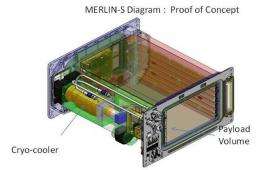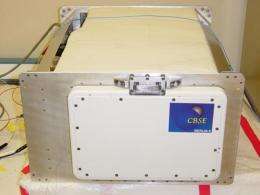Space savings for station science samples

Efficiency is the name of the game when talking about packing things into small spaces. Anyone who has ever tried to compress an overstuffed suitcase knows that one of the greatest updates to carry-on luggage was the expandable zipper feature. Little design changes like this can make a big difference in usability. This is true whether packing for vacation or, in NASA's case, when stowing research samples for travel to and from the International Space Station.
To make things even more complex, these traveling samples can have strict temperature requirements. Not maintaining the appropriate temperature could put the research at risk. NASA uses various cold stowage devices in transit and on orbit, but an escalation in science aboard station brought to light the need for more efficient options.
To address this increase, NASA welcomes a new advancement in cold stowage, called Polar. This mobile freezer maintains a chilly -80 degree Celsius temperature. Rather than an expandable zipper, however, designers recessed an internal fan into Polar's wall. This change freed up valuable interior space for science, as the area previously taken up by the fan now can house samples.

The need to develop new capabilities for cold stowage is a flow down from the ever changing constraints presented by the research. "[Cold stowage] design continues to evolve with station," said Sharon Campana, NASA's Cold Stowage Project manager. "Science requirements are being refined, and new requirements are being levied. For example there is some cell science that requires -160 degrees Celsius on ascent. This is a new requirement and will likely require new hardware to meet the requirement."
Polars are in development at the University of Alabama Center for Biophysical Science and Engineering for future use aboard the space station. They are about half the size of a college dorm mini fridge, but instead of leftover pizza, Polars will house biological samples from on orbit experiments.
Cold stowage capabilities are an important part of station research, and keeping samples at a set temperature is vital to the success of many investigations. "Some of the science being performed on station has to be processed on the ground by the principal investigator," said Campana. "In order for the science to maintain its integrity from the time the experiment is conducted, to the time it reaches the investigator on the ground, it has to remain refrigerated or frozen. Otherwise, the experiment would be lost."
The station uses a collection of cold stowage devices to meet varied cooling needs. They include MERLINs, MELFI, GLACIERs, cold stowage bags with ice bricks, and the upcoming Polars. Some of these are powered by the transport vehicle or space station, generating temperature stability. Others work like an ice chest, using chunks of ice to maintain a chilled environment. Options for sample transport with controlled temperatures are limited to GLACIERs and MERLINs right now, making the upcoming Polars a welcome addition to the cold stowage fleet.
Polars are half the size of the existing GLACIER portable freezers, but their design allows them to transport the same number of samples. "Polar provides the International Space Station Payloads Program a more efficient and volumetric means to return science from station," said Campana. "Due to the restrictions of the COTS [commercial] vehicles (power, early destow capability, etc.) and the anticipated increase in volume of science requiring a temperature controlled environment, the program felt compelled to increase their [cold stowage] capability."
NASA plans to have Polars ready for flight to the space station starting August 2014. With the research ramping up aboard the station, the increased stowage capability of these new freezers makes them a welcome addition to the cold stowage fleet, enabling researchers to pack even more for the orbital travels of their investigations.
Provided by JPL/NASA


















